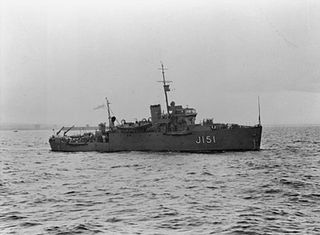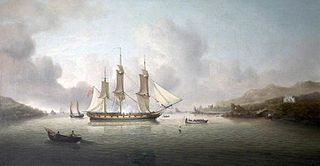
The Battle of Coronel was a First World War naval battle that led to an Imperial German Navy victory over the Royal Navy on 1 November 1914, off the coast of central Chile near the city of Coronel. The East Asia Squadron of the Imperial German Navy led by Vice-Admiral Graf Maximilian von Spee met and overpowered a British squadron commanded by Rear-Admiral Sir Christopher Cradock.

HMS Captain was a major warship built for the Royal Navy as a semi-private venture, following a dispute between the designer and the Admiralty. With wrought-iron armour, steam propulsion, and the main battery mounted in rotating armoured turrets, the ship was, at first appearance, quite innovative and formidable. However, poor design and design changes resulted in a vessel that was overweight and ultimately unstable. In terms of seaworthiness she was reported as closely comparable to the higher freeboard turret-ship HMS Monarch, but her reduced freeboard added a sense of "sluggishness". The Captain capsized in heavy seas, only five months after being commissioned, with the loss of nearly 500 lives.

HMS Ocelot (S17) is an Oberon-class diesel-electric submarine which was operated by the Royal Navy.

The Queen Elizabeth-class battleships were a group of five super-dreadnoughts built for the Royal Navy during the 1910s. These battleships were superior in firepower, protection and speed to their Royal Navy predecessors of the Iron Duke class as well as preceding German classes such as the König class. The corresponding Bayern-class ships were generally considered competitive, although the Queen Elizabeth class were 2 knots (3.7 km/h) faster and outnumbered the German class 5:2. The Queen Elizabeths are generally considered the first fast battleships of their day.

HMS Inglefield was an I-class destroyer leader built for the Royal Navy that served during World War II. She was the navy's last purpose-built flotilla leader. She was named after the 19th century Admiral Sir Edward Augustus Inglefield (1820–1894), and is so far the only warship to carry the name of that seafaring family. In May 1940, her pennant number was changed to I02.

HMS Prince of Wales was a King George V-class battleship of the Royal Navy that was built at the Cammell Laird shipyard in Birkenhead. Despite being sunk less than a year after she was commissioned, Prince of Wales had an extensive battle history, first seeing action in August 1940 while still being outfitted in her drydock, when she was attacked and damaged by German aircraft. In her brief career, she was involved in several key actions of the Second World War, including the May 1941 Battle of the Denmark Strait where she scored three hits on the German battleship Bismarck, forcing Bismarck to abandon her raiding mission and head to port for repairs. Prince of Wales later escorted one of the Malta convoys in the Mediterranean, during which she was attacked by Italian aircraft. In her final action, she attempted to intercept Japanese troop convoys off the coast of Malaya as part of Force Z when she was sunk by Japanese aircraft on 10 December 1941, two days after the attack on Pearl Harbor.

The Thames Ironworks and Shipbuilding Company, Limited was a shipyard and iron works straddling the mouth of Bow Creek at its confluence with the River Thames, at Leamouth Wharf on the west side and at Canning Town on the east side. Its main activity was shipbuilding, but it also diversified into civil engineering, marine engines, cranes, electrical engineering and motor cars.

HMS Spiteful was a Spiteful-class torpedo boat destroyer built at Jarrow, England, by Palmers Shipbuilding and Iron Company for the Royal Navy and launched in 1899. Specified to be able to steam at 30 knots, she spent her entire career serving in the seas around the British Isles.
HMS Phoebe was an Admiralty M-class destroyer built for the Royal Navy during the First World War. She took part in the Zeebrugge Raid in 1918 and was sold for scrap in 1921.

HMS Clacton was a Bangor-class minesweeper built for the Royal Navy during the Second World War.

The Bittern-class sloop was a three-ship class of long-range escort vessels used in the Second World War by the Royal Navy.

HMS Kipling (F91) was a K-class destroyer built for the Royal Navy during the 1930s.

Diffused lighting camouflage was a form of active camouflage using counter-illumination to enable a ship to match its background, the night sky, that was tested by the Royal Canadian Navy on corvettes during World War II. The principle was discovered by a Canadian professor, Edmund Godfrey Burr, in 1940. It attracted interest because it could help to hide ships from submarines in the Battle of the Atlantic, and the research project began early in 1941. The Royal Navy and the US Navy carried out further equipment development and trials between 1941 and 1943.
Five ships of the Royal Navy have borne the name HMS Enchantress:

HMS Enchantress (L56) was a Bittern-class sloop, built for the British Royal Navy. She was the lead ship of her class, being laid down as Bittern, but renamed as Enchantress before being launched by Lady Jean Alice Elaine Cochrane. She was active during the Second World War, serving mainly as a convoy escort, and was a successful anti-submarine warfare vessel, being credited with the destruction of an Italian submarine in 1942.

HMS Partridge was a Royal Navy Admiralty M-class destroyer constructed and then operational in the First World War, later being sunk by enemy action in 1917. The destroyer was the sixth Royal Navy vessel to carry the name HMS Partridge.

HMS Enchantress was the merchant ship of the same name, launched in 1802 at Ringmore, Devon. The British Royal Navy bought her in 1804. She spent her naval career at Bristol as a store ship. She was transferred to the Customs service in 1817, and may have served with it until about 1850.

HMS Poppy was a Flower-class corvette that served in the Royal Navy as a convoy escort during World War II.

HMS Amaranthus (K17) was a Flower-class corvette of the Royal Navy. She took part in the Second World War, being involved in escorting convoys from West Africa to the United Kingdom from May 1941 onwards.

















